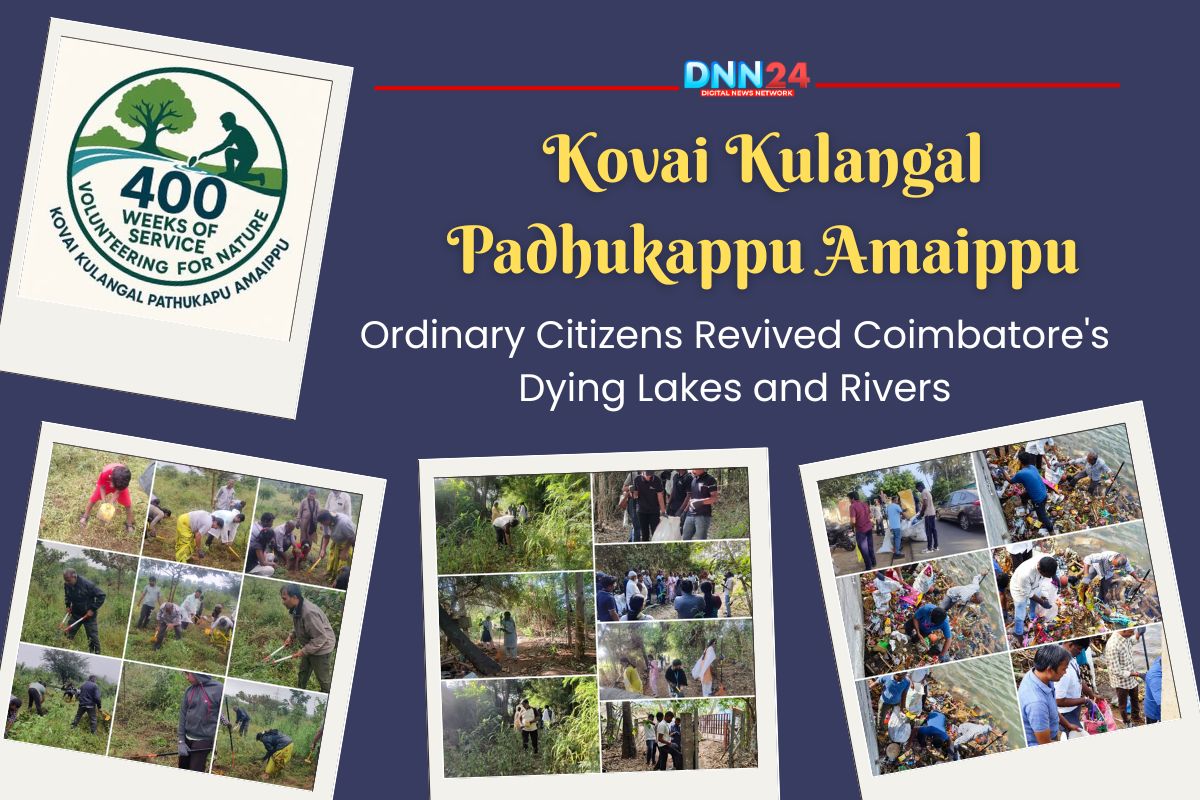When Coimbatore’s lakes became wastelands and the Noyyal River gasped under pollution, Kovai Kulangal Padhukappu Amaippu emerged as the answer fourteen determined citizens gave to a city dying of longing. Coimbatore, widely recognised as the Manchester of South India, has long been celebrated for its thriving textile industry and economic contributions. The city nestles against the Western Ghats, with the ancient Noyyal River forming the backbone of an extensive network of tanks and canals that traditionally irrigated nearly 20,000 acres of agricultural land. For generations, these water bodies sustained farmers, families, and the region’s ecological balance.
However, decades of rapid industrialisation brought severe consequences. Lakes transformed into waste dumps, ponds dried into cracked earth, and the Noyyal River gradually suffocated under industrial pollution and illegal encroachments. The city that once celebrated abundant water now faced a grim reality. By 2017, Kovai Kulangal Padhukappu Amaippu Coimbatore confronted its worst drought in recent memory. Residents adjusted to strict water rationing, and with each passing summer, the anxiety about dwindling reserves increased.
In February 2017, during this environmental emergency, fourteen concerned citizens gathered, sharing a common frustration and determination. They refused to accept the slow death of their city’s lifeline. These individuals asked themselves whether ordinary people could reverse decades of environmental damage. Their answer took shape as Kovai Kulangal Padhukappu Amaippu, a nonprofit organisation dedicated to restoring every abandoned water body in Coimbatore. The founders understood their mission extended beyond immediate relief. They envisioned creating a sustainable legacy for future generations, rebuilding not just physical infrastructure but also the community’s relationship with nature. This organisation represented more than environmental activism; it symbolised a city reclaiming its identity and promising to heal the wounds inflicted through years of neglect.
Kovai Kulangal Padhukappu Amaippu The Visionary Behind the Movement: Manikandan’s Journey
Every transformative movement needs someone willing to stand firm despite overwhelming obstacles. Manikandan, Kovai Kulangal Padhukappu Amaippu’s founder and coordinator, grew up in modest circumstances where water scarcity shaped daily existence. As a young boy, he spent his mornings fetching water for his family and wrote petitions to help elderly neighbours navigate bureaucratic systems for basic amenities. His fascination with water management began when he observed how a repaired check dam mysteriously revived a nearby well after monsoon rains. This natural phenomenon planted questions in his mind that would define his life’s work.
Manikandan faced twenty years of ridicule and rejection before achieving meaningful recognition. Local leaders dismissed him as an impractical dreamer, suggesting that someone without financial backing or political connections could never accomplish large-scale environmental restoration. Government officials often ignored his proposals, filing them away without consideration. Public meetings sometimes proceeded without acknowledging his presence. Rather than surrendering to discouragement, Manikandan treated each setback as an opportunity for learning. He studied government procedures, learned diplomatic communication, and gradually built relationships across various administrative levels.
His persistence eventually created bridges between citizens and bureaucracy, helping community members access official documents and information without exploitation or corruption. Recognition arrived quietly when the Nehru Yuvak Kendra awarded KKPA Rs. 10,000 for exemplary youth service. However, Manikandan valued something far more precious than awards. Every Sunday, surrounded by volunteers covered in mud and sweat, he would remove trash from neglected ponds while chanting encouragement to one another, finding his reward in the process. His legacy endures not in monuments but in transformed landscapes and a renewed community spirit, built gradually through countless mornings spent working toward change.
Kovai Kulangal Padhukappu Amaippu Transforming Landscapes: KKPA’s Restoration Achievements
Kovai Kulangal Padhukappu Amaippu began with small weekend cleanups that gradually expanded into a citywide environmental movement. Volunteers systematically tackled forgotten lakes, removing over 150 tonnes of accumulated plastic waste and clearing vegetation that choked waterways. Their work breathed life into water bodies that had remained dry for fifteen years. Projects like restoring Perur Lake’s 264 acres, reviving Vellalore Rajavaiykal, clearing the Kuniyamuthur Canal, and rehabilitating Kattampatty became celebrated achievements throughout Tamil Nadu.
The organisation understood that technical restoration alone could not guarantee lasting success. Kovai Kulangal Padhukappu Amaippu recognised that water bodies deteriorated when communities lost connection with them. Therefore, they focused on rebuilding this relationship by organising public events that transformed restoration into celebration. The Rally for Noyyal attracted hundreds of cyclists, while Pongal and Karthigai Deepam celebrations beside the river drew thousands of participants from diverse backgrounds. Students, shopkeepers, engineers, homemakers, and elderly residents all contributed according to their abilities and resources.
These gatherings achieved something remarkable beyond physical labour. They created shared experiences that united communities through a common purpose. Volunteers remembered laughter shared during exhausting cleanup sessions, meals prepared and distributed when energy flagged, and the profound satisfaction of seeing fish return to previously lifeless waters. Children who participated in these activities carried memories that shaped their environmental consciousness.
Kovai Kulangal Padhukappu Amaippu demonstrated that meaningful change does not require extraordinary resources or political power. Instead, it emerges from consistent effort, genuine care, and collective action. The organisation proved that when people reclaim ownership of their natural resources, those resources respond with renewed vitality. This philosophy transformed scattered individual efforts into coordinated community action, altering Coimbatore’s environmental trajectory.
Kovai Kulangal Padhukappu Amaippu Strategic Vision: Building a Sustainable Future for Coimbatore
Kovai Kulangal Padhukappu Amaippu operates with clearly defined objectives that guide all activities and partnerships. Their vision encompasses creating an environmentally balanced society where clean water remains accessible to all, biodiversity thrives, and citizens actively participate in environmental stewardship. The mission targets the explicit revival of the Noyyal River and its tributaries, expansion of green coverage, promotion of environmental education at grassroots levels, and instillation of responsibility among Coimbatore residents for their natural heritage.
The organisation collaborates actively with government agencies, contributing expertise that shapes official environmental policies. KKPA representatives deliver educational lectures at colleges, inspiring younger generations toward ecological careers. Their advocacy influenced government budgets, redirecting funds from superficial beautification projects toward essential sewage treatment infrastructure. They championed the protection of natural floodplains and promoted the planting of native species along riverbanks to prevent erosion, while supporting local ecosystems.
Government officials now consult Kovai Kulangal Padhukappu Amaippu when planning water management initiatives, recognising the organisation’s practical knowledge and community connections. This integration into formal planning processes represents a significant achievement for grassroots activism. KKPA transformed from an idealistic volunteer group into a respected stakeholder whose recommendations influence municipal decisions.
Beyond policy impact and restored ecosystems, KKPA’s most significant accomplishment may be psychological. The organisation changed how Coimbatore residents perceive their relationship with environmental challenges. Rather than viewing themselves as helpless victims of industrial pollution and governmental neglect, citizens discovered their power to create solutions. The so-called Kovai Miracle reflects not only technical achievements in lake restoration but also a fundamental transformation in community identity. Residents now approach environmental problems with confidence, understanding that collective action produces tangible results. This shift from resignation to empowerment represents KKPA’s most enduring legacy.
Kovai Kulangal Padhukappu Amaippu Stories That Inspire: The Human Heart of Environmental Action
Behind statistics about restored lakes and removed waste lie personal stories that reveal the true character of KKPA. One volunteer began her environmental activism after losing her father to a waterborne disease, channelling grief into fierce dedication to river cleanup initiatives. An auto-rickshaw driver earning modest daily wages donates Sunday afternoons and personal savings to purchase tree saplings, believing his small contributions matter. A biology student, inspired by her participation in canal restoration, now aspires to dedicate her career to environmental conservation.
Financial challenges repeatedly tested the organisation’s resolve. During periods when funds were dangerously low and continued support seemed impossible, volunteers gathered in uncertainty about their future. On several occasions, anonymous donors slipped envelopes containing just enough money for one more week’s operations under Manikandan’s door. These mysterious contributions arrived precisely when needed most, allowing work to continue.
These narratives demonstrate that environmental restoration is successful through human connection, rather than relying solely on technical expertise. KKPA’s impact spreads through individual choices to sacrifice comfort, time, and resources for collective benefit. The organisation reminds us that meaningful change begins with ordinary people making extraordinary commitments.
As the monsoons return and water flows through Coimbatore’s restored channels, this revival owes as much to human determination as it does to natural rainfall. Kovai Kulangal Padhukappu Amaippu demonstrates that transforming society requires a willingness to engage with complex, unglamorous work. Their legacy teaches that changing the world sometimes means literally getting your hands dirty, working alongside neighbours, and maintaining faith despite setbacks. This ongoing story continues to unfold, written daily by volunteers who choose hope over despair and action over resignation.
You can connect with DNN24 on Facebook, Twitter, and Instagram and subscribe to our YouTube channel.

